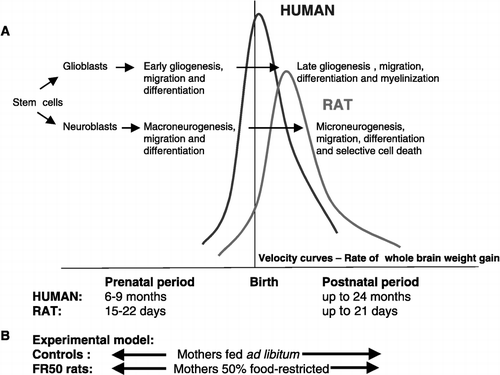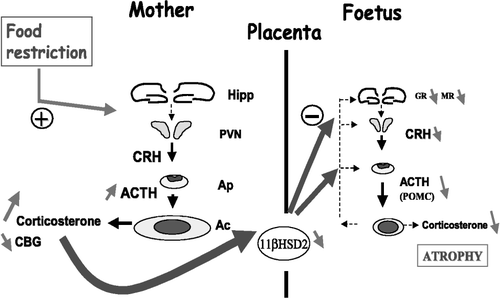Figures & data
Figure 1 (A) Comparison of the periods of brain growth and development (indicated by the velocity curves) in human and rat. The major developmental cellular processes are also shown. Note the shift of events to the early postnatal period in rats. This schema was adapted from Galler et al. (Citation1997). Below (B) is indicated the FR50 experimental model. In FR50 rats, daily maternal food intake is reduced by 50% from the last week of gestation until the end of lactation.

Figure 2 Effects of 50% food restriction during the last week of gestation on maternal and fetal HPA axis relationship in late pregnancy. Food-restriction of pregnant rats stimulates their HPA axis activity. Both plasma ACTH and corticosterone levels are increased and maternal adrenal glands are hypertrophied at the end of gestation. Maternal undernutrition also reduces both plasma CBG levels and placental 11β-HSD2 gene expression at term. As a result, rat fetuses are overexposed to high levels of free fraction of corticosterone arriving from the maternal compartment, thus potentiating the glucocorticoid negative feedback on the fetal brain and disturbing the development of their HPA axis. At the end of gestation (E21), fetuses show numerous alterations such as a drastic adrenal atrophy, reduced plasma ACTH and corticosterone levels and diminished gene expression affecting hippocampal MR and GR, hypothalamic CRH and anterior pituitary POMC. Hipp, hippocampus; PVN, hypothalamic paraventricular nucleus; Ap, anterior pituitary; Ac, adrenal cortex; MR, mineralocorticoid receptor; GR, glucocorticoid receptor; CRH, corticotrophin-releasing hormone; POMC, proopiomelanocortin; ACTH, adrenocorticotropic hormone; CBG, corticosteroid-binding globulin; 11β-HSD2, 11β-hydroxysteroid dehydrogenase type 2. (+) = positive/excitatory effect; ( − ) = negative/inhibitory effect. Based on data reported in Lesage et al. (Citation2001).

Table I. Effects of perinatal maternal undernutrition (FR50) on growth and HPA axis parameters in male rat offspring under basal conditions across the lifespan.
Table II. Effects of a 72-hour dehydration on HPA axis parameters in adult male control (C) and FR50 rats.